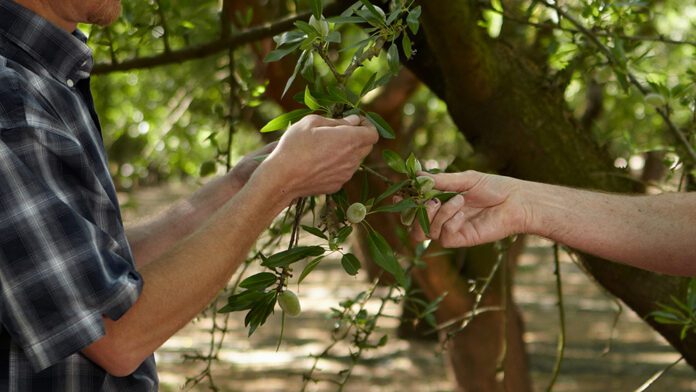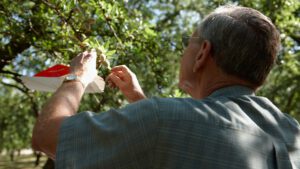
The month of May is a recognizable sign spring is here, and for almond growers, it marks a critical time: A time to monitor insects that are particularly favorable of almond orchards. Like humans, insects like to be out and about this time of year, so it is crucial growers stay on guard and vigilant to determine if and when pesticide application is needed.
It’s also important to note not all insects that surface in the spring are destructive. Come May, several beneficial insects will make their appearance, and in financially challenging years like most recently, there is a great need to take advantage of the insects that are doing good and only spend money on treatments that are absolutely necessary.
While growers are to be watchful of many insects during this time, the most active pests are spider mites, navel orangeworm (NOW) and leaffooted bug. Neither unfamiliar or uncharted, these insects are widely researched by the Almond Board of California (ABC) and industry experts, giving growers numerous resources on how to protect their almond crop.
Understanding Spider Mite Thresholds
As warmer temperatures come upon us, spider mites can be frequent visitors in almond orchards. Growers should be looking for spider mites at least weekly to keep track of bug populations, especially throughout dusty or water-stressed areas of the orchard as recommended by the UC ANR Integrated Pest Management (IPM) Program.
It’s also essential threshold levels for pesticide application are clearly understood. Growers have access to a tool through the UC Statewide IPM website that outlines guidelines on presence-absence leaf sampling, helping determine the balance between a “treat” versus “no-treat” scenario.
“You should decide to treat if there’s 1.4 mites per leaf, or 38% of leaves infested, to prevent the population from getting to 5.4 per leaf to therefore prevent economic losses,” said David Haviland, UCCE entomologist. “In those key weeks when you’re deciding if a treatment is needed, I think it’s worth the time [to sample] because you can save a lot of money by not treating using these thresholds.”
One natural treatment for spider mites is actually a beneficial insect known as six-spotted thrips. These thrips can be an effective form of management for mites and, in turn, reduce pesticide applications and the cost of spraying for growers. Industry experts, including Haviland, are encouraging the use of thrips because of their adaptability and ability to reproduce quickly with high female numbers.
“Relying on six-spotted thrips for mite management is not only effective but provides a number of operational benefits,” Haviland added. “They occur naturally, and they’re free with no residues, preharvest intervals, permits or worker safety issues to worry about. Miticides are absolutely important for managing outbreaks, but predators can help suppress mite populations, providing a buffer against catastrophe.”
Haviland’s research on this subject matter has concluded that thrips populations can be best observed using a 3×5 yellow sticky card fastened to the tree.
“If you’re finding at least one thrip on a card in April and May, and you’re below that treatment threshold of 40% leaves infested, you now have doubly confirmed reasons not to put on a May spray,” he explained.
Best Practices for Navel Orangeworm
NOW is also no stranger to the almond industry, with growers and researchers well-versed in understanding its threat to an orchard, and there is significant investment by ABC to create helpful resources.
Battling the pest takes an IPM program. Winter sanitation, the foundation of an effective program, and control applications are common knowledge in the industry, but there are other tools to consider, such as trapping and monitoring and the deployment of mating disruption.
Traps
Most commonly, the almond industry utilizes pheromone traps, Peterson traps, phenyl propionate (PPO) traps and egg traps to monitor NOW.
The pheromone traps are designed to catch the male NOW with lures that resemble a female insect, placed inside either a wing trap or a delta trap. The purpose of a pheromone trap is to determine whether a mating disruption application is working. The trap should capture few or no NOW in a mating disruption block, but in the absence of mating disruption it can show new flights, which is essential to a grower’s spray schedule.
Capturing females is a little trickier, but newer developments suggest there is still a lot of potential. Researchers have crafted a PPO trap, which contains a scent given off by a tree that female NOW find attractive. Paired with a wing or delta trap, this device has proved to be effective in capturing NOW.

Additionally, growers can catch female NOW with a Peterson trap which encompasses ground-up pistachio meats within a delta or wing trap. Once the female enters to lay their eggs, they will be successfully captured by the trap.
Egg traps focus more on capturing the eggs laid by a female NOW. With almond meal as the lure, this device hangs in a tree, and after about a week, growers should see eggs start to collect. An important factor to note is that this method should only be used early in the season because early measurement helps identify when eggs and larvae are being laid, so growers can effectively time their hull split spray and protect their almond crop.
“All these traps, regardless of the type, should be monitored at least once per week with the exception of egg traps twice a week specifically during April,” Haviland reminded.
Mating Disruption
On the other hand, when mating disruption is used, an artificial female pheromone is released into the orchard, tricking the male NOW into thinking there is a female in the area. Eventually, the male’s receptor will “fire” so frequently that it loses its ability to accurately find females. Most pheromones are aerosol products put out on each acre around April 1, and they are designed to last all season long.
Leaffooted Bug Pheromone Progress
Despite its most recent presence in orchards, leaffooted bug is the pest with the least number of resources for management. Experts still believe early monitoring is the best line of defense to keep this pest at bay, though most symptoms like gummosis and nut drop typically occur 7 to 10 days after feeding has happened. Instead, growers are encouraged to look for aborted nuts on the orchard floor or for the physical insect itself.
Fortunately, there is optimistic pheromone research in the works, funded by ABC. UC Riverside Entomology professor Jocelyn Millar has led this project with a goal of finding what compounds can be used as an effective pheromone paired with an insect trap.
With the help of Cooperative Extension Specialist Kent Daane, their studies showed a hanging cross-vane panel trap coated with a sticky substance, yellow or blue in color, performed the best for trapping leaffooted bugs. Trials to prove out this model were performed at commercial almond, pistachio and pomegranate orchards in the Central Valley and successfully supported Millar and Daane’s research.
The pheromone blend and trap will need to be perfected and further researched before it moves forward to the private sector to be commercialized. That’s where the project stands today, but industry professionals are hopeful this product will be transformative in the monitoring of leaffooted bugs in the future.
No matter the size of the operation, monitoring for these insects should be top-of-mind for growers during this time of year, especially in times like these when preventative measures can provide major cost savings down the road. For more information on how you can best set up your almond crop for success, visit the UC Statewide IPM website.















